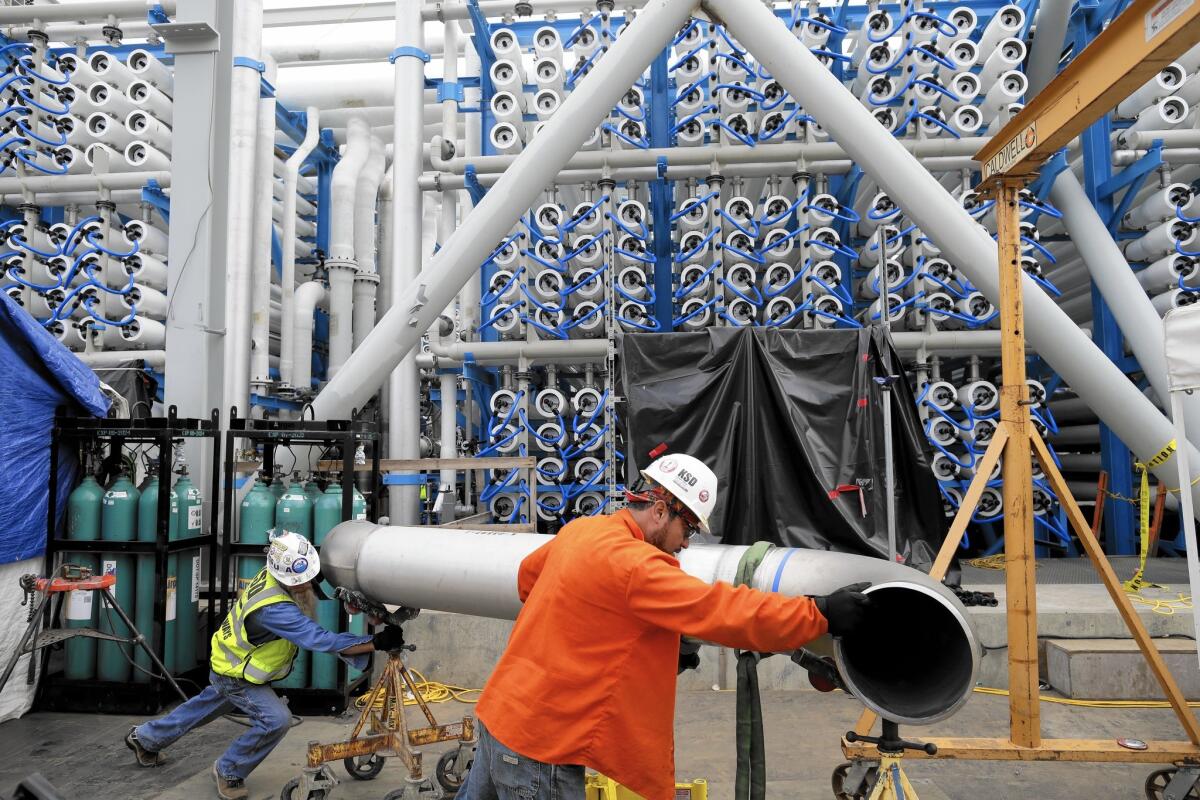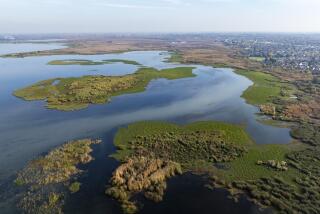Capitol Journal: Will local water projects lose out to Brown’s tunnel vision?

San Diego water officials have some cogent questions for Gov. Jerry Brown.
First, about those costly, monster tunnels he wants to dig under the Sacramento-San Joaquin River Delta: Wouldn’t it be smarter to use that money — at least a good chunk of it — to build local water projects?
Yes, delta plumbing needs to be fixed, maybe even redesigned, they acknowledge. But really? Two 40-foot-wide, 35-mile tunnels? Something smaller perhaps, combined with local recycling or desalination facilities that could produce more water?
Second, the San Diego region for two decades has been on the cutting edge of reducing water use and building facilities for the future. That includes what the county water authority calls “the nation’s largest, most technologically advanced and energy-efficient seawater desalination plant.”
So why are some of its water agencies being hit with steep, mandatory consumption cutbacks? It’s not fair, they protest.
These are questions also being asked by other water officials in California. In fact, the city of Riverside, which considers itself water-independent and doesn’t import, is suing the state over its ordered 28% cuts.
San Diego officials aren’t expecting an answer from the governor. Two years ago, they and some San Francisco Bay Area water agencies wrote the Brown and Obama administrations, raising serious concerns about the ambitious tunnel plan.
Replies “ranged from ignoring us to castigating us,” says Dennis Cushman, assistant general manager of the San Diego County Water Authority.
In the letter, the local water officials said that the proposal was “burdened with large uncertainties” and that “a solid business case has not yet been made.” There were risks to endangered species, the delta itself and water quality, they said, plus “open-ended costs” to water users combined with “political controversy and potentially lengthy litigation.”
Missing, the letter complained, was any alternative that included a smaller delta facility coupled with investments in local waterworks and storage. The water agencies suggested the tunnel capacity be cut by two-thirds.
“It would provide considerable water supply benefits,” the local officials continued, “while better protecting broader interests in the delta. Such a facility would also realize significant financial savings … face fewer legal and political challenges and potentially be completed sooner.”
Brown did alter his proposal cosmetically, but not the size. He also lowered the project cost to about $17 billion from $25 billion, mainly by significantly reducing wildlife habitat restoration.
An environmental analysis of the revised plan is due out Friday.
The San Diego water authority hasn’t taken a formal position on the project, but it remains skeptical. “We want to see a financial plan,” says board Chairman Mark Weston. “Who’s going to pay for it? And we need to know how the water would be allocated. So far, it’s looking like we’d get less water and be paying more.”
“There hasn’t been a cost-benefit analysis,” complains Maureen Stapleton, the authority’s general manager. “How much are we going to be on the hook to pay? Our ratepayers’ money is not unlimited.”
The San Diego officials were in Sacramento to vent Tuesday.
The authority includes 24 member water agencies serving 3.2 million people. In an average year, 19% of its water comes from the delta, purchased through the Metropolitan Water District of Southern California. In this drought year, however, only about 2% is from the delta.
San Diego is becoming more water-independent. A quarter-century ago, 95% of its water came from the MWD. Now less than 50% does. And in five years it’s projected to be only 30%. The rest comes from the Colorado River and locally.
Those tunnels would cost everyone who uses delta water. MWD customers would foot a large share of the bill. San Diego ratepayers could pay an extra $8 to $10 each month, it’s estimated.
For that, they could build another desalination plant that would produce more water.
The Brown administration, trying to calm Northern California fears, has been saying the tunnels wouldn’t necessarily send additional water south, just make the deliveries more reliable. In recent years, valves on the current system have frequently been tightened to protect endangered fish.
The San Diego County desalination plant, located in Carlsbad, is scheduled to begin operating in the fall. It’s costing $1 billion but is drought-proof and will supply 7% to 10% of the county’s water. Desalinated water is very expensive — about twice what is paid for MWD water — but the cost is expected to come down in future years.
Sounds like maybe a plan for other coastal communities — especially if the state were to pitch in and help.
San Diego also has doubled the capacity of its San Vicente dam to become more self-sufficient. But it’s using less water. In 1990, daily water use was 235 gallons per capita. Last year, it was 161.
So when some of its agencies were told by Sacramento to cut their water use by as much as 36%, local officials cried foul. “The state should be incentivizing, encouraging our self-help,” Stapleton contends.
I called Felicia Marcus, chairwoman of the State Water Resources Control Board, which ordered cutbacks all over California. Although there has been good conservation overall in San Diego County, she said, some agencies still are wasting too much water.
“We wanted to reward those people who stepped up when the governor asked them to” in April, she said.
Now, Brown should step up and take another look at those humongous tunnels.
Twitter: @LATimesSkelton
More to Read
Start your day right
Sign up for Essential California for news, features and recommendations from the L.A. Times and beyond in your inbox six days a week.
You may occasionally receive promotional content from the Los Angeles Times.







